신생아 기본 심폐 소생술-3, Newborn basic cardiorespiratory resuscitation-3
- 신생아(0~28일까지 기간의 아기) 기본심폐 소생술은 영유들이나 학령기 아이들을 위한 기본심폐 소생술과 다른 점이 많다.
- 신생아 학에 관련된 의료직에 종사하는 미 소아청소년과 전문의들은 신생아 심폐 소생술학을 2~3 년마다 연수해야 신생에 관련된 진료를 병원에서 계속 할 수 있는 병원 신생아 스태프 자격을 부여받을 수 있다.
- 그래서 모든 신생아과 진료를 하는 소아청소년과 전문의는 신생아 기본 심폐소생술은 물론이고 전문적 신생아 심폐 소생술을 할 수 있어야 한다.
- 신생아가 갑자기 숨을 거의 쉬지 못하거나 전혀 쉬지 않을 때나 심장이 아주 비정상적으로 느리게 뛰거나 멈춘 후 바로 인공호흡과 심장 마사지를 동시에 해야 한다( 신생아 심폐 소생술 참조).
- 우선 앞가슴이나 복부가 숨 쉴 때처럼 위쪽으로 올라갔다 내려갔다 움직이나 확인하고
- 처치자의 귀를 환아의 입과 코에 대서 환아가 숨 쉬는 대로 숨소리가 나는지, 또 숨결이 뺨에 닿나 체크해본다.
- 숨을 쉬지 않으면 기도를 열어 준다.
- 입안, 콧구멍 속, 인두강 속에 있는 분비물, 구토 물, 가래, 이물 등을 손가락으로 후비어 내거나 흡입구 등으로 흡입해 기도 내 이물을 제거해서 공기가 기도 속으로 잘 통과하도록 한다.
- 그와 동시에, 손목, 팔꿈치 앞 부위, 서혜부, 목 등에서 맥박이 뛰는지 알아본다.
- 심장이나 맥박이 비정상적으로 아주 느리게 뛰거나, 또는 아주 뛰지 않는 다고 판단했을 때는 인공호흡과 심장 마사지를 동시 시작한다.
- 그렇지만 신생아가 숨을 쉬지 못할 때는 맥박이나 심장박동이 정상인지 비정상인지 알아보기가 힘들기 때문에 숨을 거의 쉬지 못하거나 숨을 전혀 쉬지 못하면 인공호흡과 심장 마사지를 동시 하는 것이 보통이다.
- 심장 마사지를 하는 방법은 아기의 일령이나 나이, 그 외 여러 가지 조건에 따라 조금씩 다르다.
갓 태어난 신생아나 영아에게는 다음과 같이 심장 마사지를 한다.
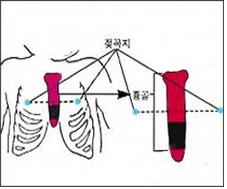
그림 269. 1. 신생아 기본심폐 소생술을 할 때 검은 색으로 표시된 흉골 부위를 손가락으로 눌러 심장 마사지를 한다.
출처; Textbook of Neonatal Resuscitation. 1987과 소아가정간호백과
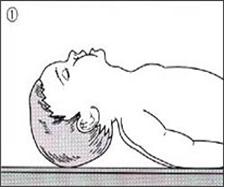
그림 270. ①: 갓 태어난 신생아 기본심폐 소생술을 할 때 단단하고 평평한 자리에 등을 대고 눕힌다. 목을 뒤로 살짝 젖혀 기도가 더 잘 열리게 한다.
출처; Textbook of Neonatal Resuscitation. 1987과 소아가정간호백과
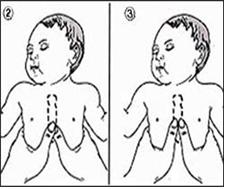
그림 271. 아기의 흉골의 아래 부위에 양쪽 엄지손가락을 그림 ②과 같이 겹쳐놓거나 그림 ③과 같이 나란히 올려놓고 나머지 손가락으로 아기의 몸통을 싸잡고 심장 마사지를 한다.
출처;Textbook of Neonatal Resuscitation. 1987과 소아가정간호백과
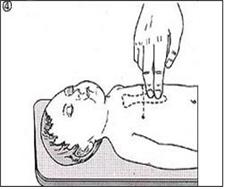
그림 272. 집게손가락과 가운데 손가락의 끝 마디 부분을 그림 ④와 같이 흉골 아래 부위에 올려놓고 신생아의 앞가슴을 등뼈가 있는 쪽을 향해 눌러 심장 마사지를 한다.
출처;Textbook of Neonatal Resuscitation. 1987과 소아가정간호백과

그림 273. 처치자의 한쪽 손으로 신생아의 등을 받치고 다른 쪽 손으로 그림 ⑤과 같이 심장 마사지를 할 수 있다.
출처; Textbook of Neonatal Resuscitation. 1987과 소아가정간호백과
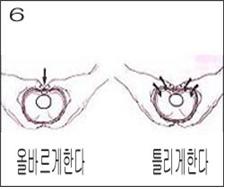
그림 274. 심장 마사지를 할 때 그림 6의 왼쪽 그림과 같이 등뼈를 향하여 앞가슴을 수직으로 눌러서 심장 마사지를 한다. 오른쪽 그림과 같이 앞가슴을 비 수직으로 눌러서는 안 된다.
심장 마사지를 할 때는 인공호흡을 항상 동시에 해야 한다. 성인의 경우는 다를 수 있다.
출처; Textbook of Neonatal Resuscitation. 1987과 소아가정간호백과
- 갓 태어난 신생아나 아주 어린 영아 환아를 단단하고 평평한 자리에 등을 대고 눕힌다(신생아의 심폐 소생술 그림 ① 참조).
- 처치자의 한쪽 엄지손가락의 끝 마디 부분을 신생아의 흉골 아래 ⅓ 부위에 올려놓은 후, 그 엄지손가락의 끝 부분 위에 다른 쪽의 엄지손가락의 끝 마디 부분을 올려놓든지(신생아의 심폐 소생술 그림 ②),
- 양쪽 엄지손가락의 끝 마디 부분을 흉골의 아래 ⅓ 부분에 나란히 올려놓는다(신생아의 심폐 소생술 그림 ③).
- 나머지 양쪽 손의 손가락들과 손바닥으로 신생아의 몸통을 싸잡고 심장 마사지를 하든지, 한쪽 손의 집게손가락과 가운데 손가락의 끝 마디 부분은 흉골의 아래 ⅓ 부분에 올려놓고 등뼈를 향하여 가슴을 ½∼¾㏌(신생아 경우)나
- 1~1.5㏌(1~8세 유아나 학령기 아이 경우)를 흉강 속 쪽으로 눌러 심장 속에 있던 피가 전신으로 흘러가도록 심장 마사지를 한다( 신생아의 심폐 소생술 그림 ④).
- 심장 마사지를 신생아에게 할 때는 1분에 100회 한다.
- 심장 마사지를 3번 한 후 인공호흡을 한번 한다.
- 1~8세나 그 이상 된 학령기 환아에게 심장 마사지를 할 때는 심장 마사지를 하는 사람의 한쪽 손바닥이나 양쪽 손바닥을 그 환아의 흉골의 중간 부분의 바로 아래 부위에 올려놓고 1분에 100번 정도 한다.
- 다시 설명하면 처치자가 2~2.5초 동안에 ‘하나’라고 소리 내어 세면서 첫 번째 심장 마사지를 해 주고, 둘이라고 소리 내어 세면서 두 번째 심장 마사지를 하고, 셋이라고 소리를 내면서 세 번째 심장 마사지를 하고, 바로 다음 인공호흡을 한 번 한다.
- 그 다음 또다시 같은 요령으로 2~2.5초 동안에 하나, 둘, 셋을 전과 같이 세면서 앞에서와 같이 심장 마사지를 연거푸 3번 하고 인공호흡을 한 번 한다.
- 두 사람 이상이 있을 때는 한 사람은 인공호흡을, 다른 사람은 심장 마사지를 한다. 그렇지만 한 사람만 있을 때는, 한 사람이 인공호흡과 심장 마사지를 다 하면서 다른 사람에게 도움을 청한다.
Newborn basic cardiorespiratory resuscitation-3
• Basic CPR for newborns (babies from 0 to 28 days) differs from basic CPR for infants and school-age children.
• American pediatricians working in medical professions related to neonatology must train neonatal cardiopulmonary resuscitation every 2-3 years in order to be eligible for hospital neonatal staff qualifications who can continue newborn-related care in hospitals.
• Therefore, pediatricians who perform all neonatal care should be able to perform basic neonatal CPR as well as specialized neonatal CPR.
• Simultaneous ventilation and cardiac massage should be given simultaneously when the newborn suddenly has little or no breathing, or immediately after the heartbeats or stops very unusually slowly (see Neonatal CPR).
• First, check whether the chest or abdomen moves upwards and downwards like breathing. • Put the patient’s ear to the child’s mouth and nose to check if breathing sounds as the patient breathes and if the breath touches the cheeks.
• If not breathing, open the airway.
• Pick up secretions, vomit, sputum, and foreign objects in the mouth, in the nostrils, and in the pharynx with your fingers or inhale through the inhaler to remove foreign objects from the airways to allow air to pass through the airways.
• At the same time, check for pulses in the wrists, the front of the elbow, the groin, and the neck. • If it is determined that the heart or pulse is abnormally very slow or not beating very much, start artificial respiration and cardiac massage at the same time.
• However, when a newborn is not breathing, it is difficult to determine whether the pulse or heartbeat is normal or abnormal, so it is common to perform artificial respiration and cardiac massage at the same time if the newborn is barely breathing or not breathing at all. • The method of heart massage differs slightly depending on the age, age, and other conditions of the baby. For newborns and infants, give a heart massage as follows.

Figure 269. 1. When performing basic cardiopulmonary resuscitation (CPR) for newborns, massage the heart by pressing the black marked sternum with your fingers. source; Textbook of Neonatal Resuscitation. Lesson 1987 Encyclopedia of Pediatric and Family Nursing

Figure 270. ①: When performing basic cardiopulmonary resuscitation (CPR) for newborns, lay them on their backs on a firm, flat surface. Tilt your neck slightly back to better open the airway. source; Textbook of Neonatal Resuscitation. Lesson 1987 Encyclopedia of Pediatric and Family Nursing

Figure 271. Place both thumbs on the lower part of the baby’s sternum as shown in picture ② or side by side as shown in picture
③, wrap the baby’s body with the rest of the fingers and massage the heart. Source; Textbook of Neonatal Resuscitation. Lesson 1987 Encyclopedia of Pediatric and Family Nursing

Figure 272. Place the tip of the index finger and middle finger on the lower part of the sternum as shown in Figure
④, and press the newborn’s forearm toward the spine to massage the heart. Source; Textbook of Neonatal Resuscitation. Lesson 1987 Encyclopedia of Pediatric and Family Nursing

Figure 273. The patient can support the newborn’s back with one hand and use the other hand to massage the heart as shown in Figure
⑤. source; Textbook of Neonatal Resuscitation. Lesson 1987 Encyclopedia of Pediatric and Family Nursing

Figure 274. When doing a heart massage, as in the left figure of Figure 6, press the chest vertically toward the spine to perform a heart massage. As shown in the picture on the right, do not press the front chest non-vertically.
When performing cardiac massage, artificial respiration should always be performed at the same time. For adults, it may be different. source; Textbook of Neonatal Resuscitation. Lesson 1987 Encyclopedia of Pediatric and Family Nursing
• Place a newborn or very young infant on his or her back on a firm, flat surface (refer to the newborn cardiopulmonary resuscitation figure ①).
• After placing the tip of one thumb of the operator on the ⅓ area below the sternum of the newborn, place the tip of the other thumb on top of the tip of the thumb (cardiopulmonary resuscitation of a newborn baby
②) • Place the tip of both thumbs side by side on the lower ⅓ part of the sternum (cardiopulmonary resuscitation for newborn baby
③). • Wrap the newborn baby’s torso with the fingers and palms of the other hands and massage the heart, or place the tip of the index finger and middle finger of one hand on the lower third of the sternum and lift the chest toward the spine by ½ to ¾ ㏌ (for newborns) or
• Press 1~1.5㏌ (for infants aged 1~8 years old or school-age children) into the chest cavity and massage the heart so that the blood in the heart flows to the whole body (CPR for newborns
④). • When giving a heart massage to a newborn, do 100 times per minute. • After 3 cardiac massages, give artificial respiration once.
• When performing cardiac massage for school-age children aged 1 to 8 years or older, place one or both palms of the person doing the heart massage on the area just below the middle of the child’s sternum and do it about 100 times per minute.
• To reiterate, the practitioner performs the first heart massage while counting out ‘one’ for 2 to 2.5 seconds, performing a second heart massage while counting aloud to two, and performing a third heart massage while counting out three; Immediately perform one artificial respiration.
• Then again, repeating the same procedure for 2 to 2.5 seconds, counting one, two, three as before, perform cardiac massage three times in succession as before and perform artificial respiration once.
• When there are more than one person, one person performs artificial respiration and the other performs heart massage. However, when there is only one person, one person does both artificial respiration and heart massage, asking the other for help.
출처 및 참조 문헌 Sources and references
- NelsonTextbook of Pediatrics 22ND Ed
- The Harriet Lane Handbook 22ND Ed
- Growth and development of the children
- Red Book 32nd Ed 2021-2024
- Neonatal Resuscitation, American Academy Pediatrics
- 신생아 심폐 소생술
- 호흡곤란
- 콧구멍 속 이물, 비강 속 이물, 외비공의 이물
- 기도 속에 이물이 들어갔을 때와 질식
- 하임리크 처치법
- 생선가시가 목구멍 속에 걸렸을 때
- 소화기 속 이물, 소화관내 이물, 위장관 내 이물
- 질식
- www.drleepediatrics.com 제1권 소아청소년 응급 의료
- www.drleepediatrics.com 제2권 소아청소년 예방
- www.drleepediatrics.com 제3권 소아청소년 성장 발육 육아
- www.drleepediatrics.com 제4권 모유,모유수유, 이유
- www.drleepediatrics.com 제5권 인공영양, 우유, 이유식, 비타민, 미네랄, 단백질, 탄수화물, 지방
- www.drleepediatrics.com 제6권 신생아 성장 발육 육아 질병
- www.drleepediatrics.com제7권 소아청소년 감염병
- www.drleepediatrics.com제8권 소아청소년 호흡기 질환
- www.drleepediatrics.com제9권 소아청소년 소화기 질환
- www.drleepediatrics.com제10권. 소아청소년 신장 비뇨 생식기 질환
- www.drleepediatrics.com제11권. 소아청소년 심장 혈관계 질환
- www.drleepediatrics.com제12권. 소아청소년 신경 정신 질환, 행동 수면 문제
- www.drleepediatrics.com제13권. 소아청소년 혈액, 림프, 종양 질환
- www.drleepediatrics.com제14권. 소아청소년 내분비, 유전, 염색체, 대사, 희귀병
- www.drleepediatrics.com제15권. 소아청소년 알레르기, 자가 면역질환
- www.drleepediatrics.com제16권. 소아청소년 정형외과 질환
- www.drleepediatrics.com제17권. 소아청소년 피부 질환
- www.drleepediatrics.com제18권. 소아청소년 이비인후(귀 코 인두 후두) 질환
- www.drleepediatrics.com제19권. 소아청소년 안과 (눈)질환
- www.drleepediatrics.com 제20권 소아청소년 이 (치아)질환
- www.drleepediatrics.com 제21권 소아청소년 가정 학교 간호
- www.drleepediatrics.com 제22권 아들 딸 이렇게 사랑해 키우세요
- www.drleepediatrics.com 제23권 사춘기 아이들의 성장 발육 질병
- www.drleepediatrics.com 제24권 소아청소년 성교육
- www.drleepediatrics.com 제25권 임신, 분만, 출산, 신생아 돌보기
- Red book 29th-31st edition 2021
- Nelson Text Book of Pediatrics 19th- 21st Edition
- The Johns Hopkins Hospital, The Harriet Lane Handbook, 22nd edition
- 응급환자관리 정담미디어
- Pediatric Nutritional Handbook American Academy of Pediatrics
- 소아가정간호백과–부모도 반의사가 되어야 한다, 이상원 저
- The pregnancy Bible. By Joan stone, MD. Keith Eddleman, MD
- Neonatology Jeffrey J. Pomerance, C. Joan Richardson
- Preparation for Birth. Beverly Savage and Dianna Smith
- 임신에서 신생아 돌보기까지. 이상원
- Breastfeeding. by Ruth Lawrence and Robert Lawrence
- Sources and references on Growth, Development, Cares, and Diseases of Newborn Infants
- Emergency Medical Service for Children, By Ross Lab. May 1989. p.10
- Emergency care, Harvey Grant and Robert Murray
- Emergency Care Transportation of Sick and Injured American Academy of Orthopaedic Surgeons
- Emergency Pediatrics A Guide to Ambulatory Care, Roger M. Barkin, Peter Rosen
- Quick Reference To Pediatric Emergencies, Delmer J. Pascoe, M.D., Moses Grossman, M.D. with 26 contributors
- Neonatal resuscitation Ameican academy of pediatrics
- Pediatric Nutritional Handbook American Academy of Pediatrics
- Pediatric Resuscitation Pediatric Clinics of North America, Stephen M. Schexnayder, M.D.
-
Pediatric Critical Care, Pediatric Clinics of North America, James P. Orlowski, M.D.
-
Preparation for Birth. Beverly Savage and Dianna Smith
-
Infectious disease of children, Saul Krugman, Samuel L Katz, Ann A.
- 제4권 모유, 모유수유, 이유 참조문헌 및 출처
- 제5권 인공영양, 우유, 이유, 비타민, 단백질, 지방 탄수 화물 참조문헌 및 출처
- 제6권 신생아 성장발육 양호 질병 참조문헌 및 출처
- 소아과학 대한교과서
Copyright ⓒ 2014 John Sangwon Lee, MD., FAAP
“부모도 반의사가 되어야 한다”-내용은 여러분들의 의사로부터 얻은 정보와 진료를 대신할 수 없습니다.
“The information contained in this publication should not be used as a substitute for the medical care and advice of your doctor. There may be variations in treatment that your doctor may recommend based on individual facts and circumstances.
“Parental education is the best medicine.